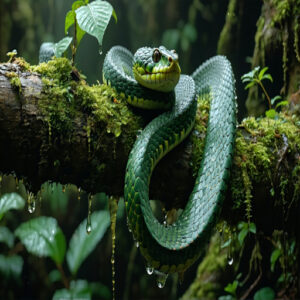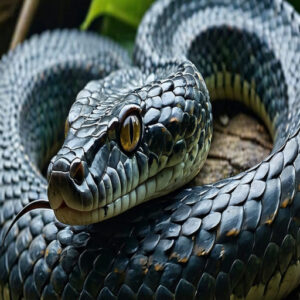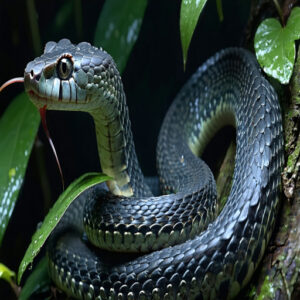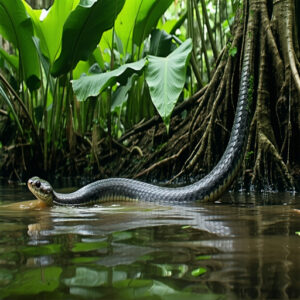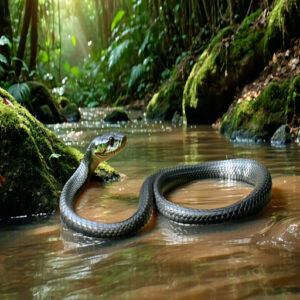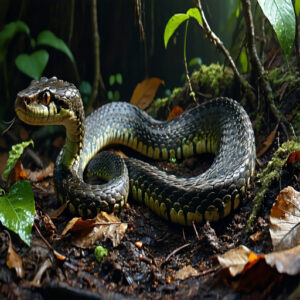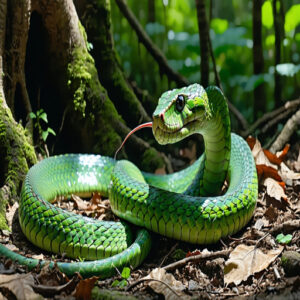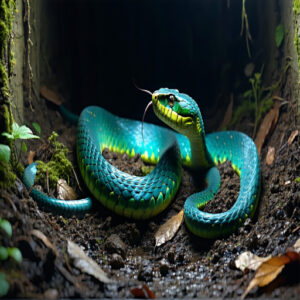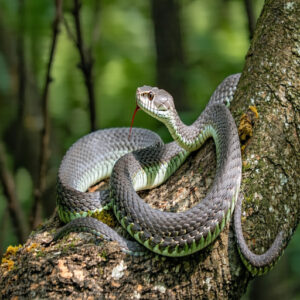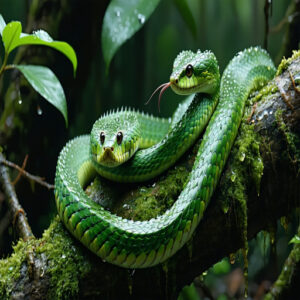This site is supported by our readers. We may earn a commission, at no cost to you, if you purchase through links.

They’re famous for their rough, keeled scales that resemble a dragon’s armor, giving them a unique beaded texture.
These slender snakes, typically ash-gray to black, grow up to 3 feet long, with females slightly larger than males.
Dragon snakes are picky eaters, preferring aquatic prey like frogs, tadpoles, and small fish, and they’re surprisingly prone to stress, even refusing food if unsettled.
Their stiff, frozen defensive posture when threatened is just one of their many fascinating quirks. Curious yet?
Table Of Contents
- Key Takeaways
- What is a Dragon Snake?
- Dragon Snake Facts and Information
- Dragon Snake Habitat and Distribution
- What Do Dragon Snakes Eat?
- How Venomous Are Dragon Snakes?
- Dragon Snake Reproduction and Life Cycle
- Dragon Snake Behavior and Social Structure
- Conservation Status of Dragon Snakes
- Dragon Snakes in Captivity
- Interesting Dragon Snake Facts and Research
- Frequently Asked Questions (FAQs)
- Are dragon snakes omnivores, herbivores, or carnivores?
- Can you own a pet dragon snake?
- How long do dragon snakes live?
- How often do dragon snakes breed?
- What are some interesting facts about the dragon snake?
- Can you keep a dragon snake as a pet?
- Where do dragon snakes live?
- What is the behavior of a dragon snake?
- Why do dragons resemble snakes?
- What do you know about dragons?
- Conclusion
Key Takeaways
- You’ll find dragon snakes in humid, swampy areas of Southeast Asia, where they rely on wetlands and forest floors to thrive.
- These non-venomous reptiles are picky eaters, sticking to a diet of small fish, frogs, tadpoles, and they even refuse food when stressed.
- Dragon snakes defend themselves by stiffening their bodies, cloacal popping, and blending into their surroundings rather than attacking.
- They’re delicate in captivity, needing high humidity, low stress, and a strict diet, making them a challenge even for experienced reptile keepers.
What is a Dragon Snake?
You’ve probably never seen a snake quite like the dragon snake, a rare, spiky-scaled reptile found in Southeast Asia.
With its rough, keeled scales and sleek, unique appearance, it’s as fascinating as it’s elusive.
Scientific Name and Taxonomy
A dragon snake’s scientific name, Xenodermus javanicus, reveals its unique place in taxonomy.
Belonging to the family Xenodermidae and the genus Xenodermus, it stands out with its fascinating taxonomic history.
Curious about its evolutionary quirks? This species defies snake stereotypes through its distinctive phylogenetic analysis.
It’s like nature’s way of showing off, crafting a creature unlike any other!
Physical Description
Think of a dragon snake as nature’s artwork.
Its scale patterns gleam like rippling water, with coloration shifting between ash gray and deep black.
The body shape is slender yet strong, while its snout structure is narrow and sharply defined.
Topping it off, the rugged dorsal scales create pronounced ridges, showcasing their keeling features in breathtaking detail.
The dragon snake’s unique appearance is reminiscent of a real dragon snake, with characteristics that distinguish it from other species.
Size and Appearance
If you’ve ever seen a Xenodermus javanicus, you know their dragon snake appearance is unforgettable.
Their slender, muscular bodies are accented by rows of keeled scales, giving them a rugged, almost beaded texture.
Their oblong heads, paired with intricate scale patterns, look like a piece of natural art.
Color variations range from ash gray to deep black, often shimmering with an iridescent glow.
Here’s why their morphology stands out:
- Elongated body proportions
- Pointed, narrow snouts
- Unique rowed scale patterns
- Contrasting visual features
Dragon Snake Facts and Information
Dragon snakes are fascinating reptiles native to Southeast Asia, thriving in humid forests, swamps, and rice paddies.
Their diet mainly consists of aquatic prey like tadpoles and small fish, making them unique among snakes.
Native Range and Habitat Preferences
In terms of their home turf, Xenodermus javanicus—better known as the dragon snake—sticks to Southeast Asia’s humid terrains.
These quirky swamp-dwellers love wetland areas and forest floors across Java, Thailand, and similar spots.
Whether slithering through rice paddies or lounging in swamp ecosystems, their ideal habitat blends moisture with quietude.
The dragon snake’s unique characteristics can be found in the snake species classification.
Here’s the breakdown:
| Type | Habitat | Features |
|---|---|---|
| Swamps | Marshy wetlands | High humidity |
| Forest Floors | Lowland forests | Shady, moist areas |
| Agriculture Zones | Rice fields | Artificial wetlands |
Human encroachments disrupt many such dragon snake habitats—though these little survivors adapt surprisingly well to altered terrains.
Elevation Ranges and Geographic Distribution
Dragon snakes thrive in Southeast Asia’s lush terrains, favoring forest ecosystems and island habitats with the perfect balance of elevation and moisture.
Their geographic distribution stretches through Thailand, Malaysia, Indonesia, and Myanmar, primarily in mountainous regions.
- They prefer elevations from 500 to 1,100 meters, staying close to the water table.
- Found in marshes, rice paddies, and tropical lowlands.
- Often overlap with other Malaysia and Thailand snake species.
- Sensitive to terrain changes, making terrain mapping essential.
- Unique adaptations suit specific elevation zones.
Diet and Prey Species
Ever picture snake foraging like a covert operation? Xenodermus javanicus, a master of stealth, thrives on a diet of fish prey and amphibians like frogs and tadpoles.
Occasionally, aquatic insects and crustaceans spice up their meals, especially during the wet season. While they’re all about aquatic hunting, rodents rarely make the menu—talk about picky!
If you’re curious about dragon snake diet products, focus on options matching their natural prey for happy, healthy reptiles in captivity.
Dragon Snake Habitat and Distribution
You’ll find dragon snakes in the humid, forested lowlands of Southeast Asia, often lurking near swamps or rice paddies. They stick to cozy microclimates, preferring elevations between 1650 and 3600 feet.
Native Range and Geographic Distribution
Meet Xenodermus javanicus, a mysterious Southeast Asia snake found in places like Indonesia, Malaysia, and Java.
Their habitat fragmentation reflects their ability to thrive in humid, forested lowlands, often near water, and they’ve adapted well within geographic isolation.
Their range also includes elevation effects, with most living between 500 and 1,100 meters, which is a notable aspect of their swampy niches, and they’re rarely seen expanding beyond these areas, keeping them an enigma for researchers and nature lovers alike, leaving many curious about species migration.
Habitat Preferences and Elevation Ranges
Dragon snakes, or Xenodermus javanicus, are masters of blending into forest ecosystems, thriving in Southeast Asia’s wetland habitats and along mountain ranges.
These elusive reptiles favor high-humidity areas with unique terrain features, from Java’s forests to aquatic zones near rice paddies.
With elevations ranging between 1650-3600 feet, their habitat preferences highlight remarkable adaptations to life’s delicate balance in changing environments.
Adaptation to Different Environments
Adaptable yet selective, the xenodermus javanicus, or dragon snake, thrives across diverse habitats thanks to its keen microclimate preferences.
As a semifossorial snake, it burrows for shelter and survival, showcasing impressive ecosystem resilience.
This nocturnal snake expertly balances climate tolerance and camouflage, adjusting to varied environments across its geographic distribution.
These fascinating creatures are non-venomous, as detailed on this dragon snake webpage.
Its environmental adaptations make it a master of stealth and survival.
What Do Dragon Snakes Eat?
Dragon snakes are picky eaters, sticking to a menu of aquatic frogs, tadpoles, and small fish.
If you’re thinking of offering them a mouse, think again—they’ll ignore it completely!
Prey Species and Hunting Behavior
In the context of catching their food, Xenodermus javanicus relies on clever ambush strategies and sharp hunting tactics.
Here’s how they operate:
- Spot Prey with Infrared Detection: They locate aquatic prey like frogs and tadpoles.
- Stay Hidden: Camouflage perfectly in water or mud.
- Swift Attack: Precision strikes guarantee success.
- Adapt Instinctively: Defensive if needed, but always calculated.
Feeding in Captivity and Dietary Requirements
Feeding a captive dragon snake takes patience and a bit of strategy.
These picky eaters thrive on small feeder fish or amphibians that match their girth.
Stick to a captive feeding frequency of twice a week to balance their nutritional needs and support digestive health.
Occasionally, consider supplementation to keep things varied.
For superior results, understanding dragon snake food is vital.
If fish aren’t available, some prey alternatives like tadpoles can work.
Add aquatic features to their enclosure—snakes hunt better when it feels natural.
Remember, a healthy snake diet equals a healthy snake!
Unique Feeding Habits and Characteristics
The dragon snake’s feeding habits are as fascinating as its name.
This unique snake species, Xenodermus javanicus, uses stealthy hunting techniques and aquatic adaptations to capture prey like frogs and tadpoles.
Let’s break it down with some cool dragon snake facts:
- Prey capture methods: Unlike other snakes, they rely on precision instead of venom.
- Aquatic adaptations: Infrared-sensitive receptors help detect prey underwater.
- Snake nutrition: Their diet is strictly amphibian, so forget the idea of feeding them mice.
- Feeding frequency: They prefer infrequent meals, one every 5-10 days.
How Venomous Are Dragon Snakes?
You don’t need to worry about dragon snakes being dangerous—they’re completely non-venomous.
Instead of venom, they rely on unique defensive behaviors like stiffening up or emitting popping sounds to ward off predators.
Venom Potency and Composition
Dragon snakes might look like they pack a punch, but they’re not venomous.
Forget toxin levels or venom potency—these snakes rely on stealth, not snake bites or poison effects, to hunt.
Unlike venomous snakes, there’s no venom analysis or compound structure to study here.
Their charm lies in spiky scales and defensive postures, making them nature’s quiet, quirky marvels.
| Trait | Dragon Snakes | Venomous Snakes Guided Comparison | Fun Fact |
|---|---|---|---|
| Presence of Venom | None | Yes | Dragon snakes win at harmless charm! |
| Hunting Style | Stealth, aquatic prey | Often fangs and venom injection | Efficient hunters in unique ways |
| Defense Mechanism | Cloacal popping, stiffening, motionless posture | Striking, releasing venom | Dragon snakes specialize in stoic shows! |
| Prey | Frogs, small fish, tadpoles |
Their unique characteristics and behaviors make them fascinating creatures, with a quiet and efficient approach to hunting and defense, showcasing their defensive postures as a key survival strategy.
Danger to Humans and Defensive Behaviors
You don’t need to worry about dragon snakes launching an attack—they’re more bluff than bite.
Their defensive mechanisms are fascinating and clever rather than dangerous. So, are dragon snakes venomous? No, but they’ve got impressive moves to deter predators.
- Cloacal popping: Think of it as their loud “no trespassing” alarm.
- Body flattening: They spread wide to trick predators into thinking they’re much bigger.
- Freeze defense: Under stress, they stiffen like a stick, blending into their surroundings.
For human safety, these reptiles prefer defense over offense—smart snakes!
Treatment and Antidotes for Bites
Wondering what to do if a dragon snake bites you? Here’s the scoop: these snakes aren’t venomous, so antivenom and treatments for venom potency aren’t concerns.
However, every snakebite warrants attention to prevent infection and complications. Take these first aid steps: clean the wound thoroughly with soap and water, ensuring no debris lingers. If swelling or redness occurs, elevate the limb and monitor symptoms like pain or numbness.
While dragon snakes won’t inject venom, confusing a harmless species with a venomous one can happen. A venomous snake identification guide helps avoid missteps. If you’re unsure, always seek medical treatment just to be safe.
For severe symptoms (e.g., difficulty breathing or paralysis from another snake species), get help immediately. Snakebite first aid can’t replace swift, professional intervention in life-threatening cases.
Dragon Snake Reproduction and Life Cycle
In the context of reproduction, dragon snakes have a fascinating but low-key approach, marked by their intricate courtship rituals and small yearly egg clutches.
Their young grow quickly, with genetics, diet, and environment playing a big part in their development.
Mating and Courtship Behaviors
When it’s mating season, dragon snakes skip flashy moves or big drama.
Instead, they rely on chemical signals—like sending invisible love notes through pheromones—to attract mates.
Their courtship rituals are subtle, almost like a secret handshake in nature.
Once paired, they shift focus to breeding seasonality, searching for safe nesting spots to support their offspring’s early stages in the life cycle.
Egg-laying and Incubation Periods
Egg-laying in dragon snakes is an intricate part of their reproduction and life cycle.
These snakes lay small clutches—usually 2-4 eggs—during the rainy season, selecting humid, hidden spots for safety.
Their eggs are pearl-like and delicate, requiring careful handling.
Incubation periods last 40-70 days, influenced by the incubation temperature (range: 82-88°F).
Too much heat? The embryos won’t survive.
Want success? Here’s how:
- Set up a nesting box: Use moist soil or sand to mimic their natural environment.
- Monitor humidity: Keep it high but avoid mold growth.
- Handle eggs gently: Mark them to guarantee proper orientation, avoiding harm.
Hatchlings emerge fully self-sufficient yet fragile.
Lifespan and Growth Rates
Dragon snakes, or Xenodermus javanicus, grow at a pace defined by genetics and their environment.
Their 10-year lifespan depends heavily on health impacts from care and diet.
You’ll notice growth patterns slow as they age, a natural rhythm tied to maturation rates.
Want longer-lived snakes? Focus on steady conditions! Understanding snake species lifespan is essential for their care.
These fascinating Java-native reptiles demonstrate unique age factors that make their journey through life a remarkable part of dragon snake facts.
Dragon Snake Behavior and Social Structure
Regarding behavior, dragon snakes are nocturnal loners, preferring to stay hidden during the day in burrows or muddy habitats.
They’re not social creatures, but their stiff “frozen” defense posture is oddly fascinating.
Activity Patterns and Daily Routines
Ever wondered how dragon snakes manage their day? These masters of stealth thrive on their nocturnal habits, reserving rare daytime activity for basking or avoiding predators.
They adjust their daily movements to temperature shifts and seasons. Their hiding behavior during the day keeps them safe in underground burrows. At night, they focus on hunting strategies, driven by prey availability and environmental influences.
- Night activity peaks for hunting frogs and tadpoles.
- Daytime hiding reduces predator risk.
- Seasonal shifts impact activity patterns.
Social Interactions and Communication Methods
You’ll rarely spot dragon snakes forming a social structure—they’re more introverted than other snakes.
Their limited interaction relies on tactile communication and subtle visual displays, especially during breeding rituals.
Nocturnal snakes like these may also use chemical signaling, possibly “chatting” through scents you can’t detect.
Dragon snakes utilize chemical communication methods to convey essential information.
Their semifossorial behavior means their communication stays understated—a quiet exchange of posture shifts and unseen cues that suits their private, underground lifestyles perfectly.
Defensive Posturing and Threat Displays
When danger strikes, dragon snakes don’t rely on venom potency but instead master fear displays and defensive postures.
They startle predators using these impressive defense mechanisms:
- Cloacal popping: A loud, startling sound to confuse threats.
- Body flattening: Making themselves appear wider and more intimidating.
- Snake body language: Stiffening like a frozen stick.
- Hissing and tail rattling: Classic attack avoidance tactics.
- Defensive coloration: Staying invisible against the backdrop.
These mechanisms are crucial for the snakes’ survival, as they effectively deter predators without the need for venom, highlighting the importance of adaptive defense and the role of fear displays in the animal kingdom, particularly in species like the dragon snake that utilize defensive postures.
Conservation Status of Dragon Snakes
You’ve probably never thought about how vulnerable dragon snakes are, but their shrinking habitats and human activity are serious threats.
Conservation programs and habitat protection efforts are essential to keeping these rare snakes around for future generations.
IUCN Red List Category and Population Trends
Dragon snakes, or Xenodermus javanicus, aren’t currently listed on the IUCN Red List, but their conservation status raises eyebrows.
Population trends hint at a decline, driven by habitat loss and human pressures.
Without proper assessment criteria and conservation actions, their future prospects look shaky. These rare snakes could quietly vanish without notice—proof that not all threatened species make headlines.
Threats and Challenges to Survival
Why are dragon snakes struggling? It’s a mix of habitat loss, human activity, and pollution effects.
Their forests are shrinking as people claim more land, leaving these snakes fewer places to roam. Add climate change into the equation, which disrupts their watery microhabitats, and it only gets worse.
- Illegal collection pressure: Some are poached for the exotic pet trade.
- Disease risks: Stress from environmental changes makes outbreaks more likely.
- Pollution: Contaminants harm their sensitive ecosystems.
These factors challenge their conservation status and could impact future IUCN Red List updates.
Conservation Efforts and Programs
Protecting these incredible creatures takes teamwork.
Captive breeding programs stabilize populations, with habitat restoration giving dragon snakes space to thrive.
Population monitoring reveals shifting population trends, guiding smarter decisions.
Public support grows through awareness campaigns, while legal protection shields them from harm.
Every effort strengthens snake conservation, ensuring they stay off the IUCN Red List—and right where they belong: in the wild.
Dragon Snakes in Captivity
If you’re thinking about keeping a dragon snake, you’ll need to recreate their natural humid, cooler environment to keep them healthy.
These shy, stress-prone snakes require precise care, making them a challenge even for experienced reptile enthusiasts.
Captive Care Requirements and Housing
Setting up a dragon snake enclosure? It’s all about comfort and nature-inspired details. A cozy, well-thought-out enclosure setup guarantees your snake stays healthy and stress-free.
When designing a dragon snake enclosure, consider the space and layout to mimic their natural habitat.
- Enclosure size: A minimum of 20” x 10” x 12” is great. Bigger? Even better.
- Humidity control: Keep it high at 85-95% to mimic their tropical homeland.
- Substrate choices: Go natural with sphagnum moss, coconut coir, or organic soil.
Oh, and don’t forget the basics of snake husbandry—add two comfy hiding places and keep temperatures comfy with proper heating options!
Breeding in Captivity and Propagation Methods
Breeding dragon snakes in captivity can feel like solving a complex puzzle.
Recent successes in Moscow Zoo show it’s possible, but you’ll need to master specific techniques.
Spring and early summer offer your best shot at snake breeding, with most captive dragon snakes laying 2-4 eggs.
Successful snake breeding programs require careful planning and attention to detail.
While wild-caught specimens often struggle with stress, a handful of expert breeders have cracked the code.
Legality of Ownership and Permits
Owning a dragon snake is more than setting up a habitat—it’s about checking the legality of exotic pets.
Here’s how to stay compliant:
- Permit Requirements: Some states require ownership permits for exotic pets.
- Ownership Laws: Federal laws might need breeding licenses.
- Regulatory Compliance: Always confirm local restrictions to avoid fines.
Legal research protects you and your scaly companion!
Interesting Dragon Snake Facts and Research
You’ll find dragon snakes fascinating, thanks to their unique spiked scales and secretive habits that set them apart from other reptiles.
Researchers are still uncovering their evolutionary history, mysterious behaviors, and cultural significance.
Unique Physical Traits and Adaptations
Dragon snakes, or Xenodermus javanicus, are nature’s stealth experts with mesmerizing scaly patterns and iridescent scales.
Their spiky dorsal scales and slender body shape play a key role in blending into marshy habitats. With no venom glands, these beauties rely on sharp snake senses and stealth to hunt.
Their unique tail structure adds balance during movement or burrowing. Plus, their coloration—deep blacks and grays with contrasting designs—adds both beauty and utility.
| Feature | Function |
|---|---|
| Spiky Dorsal Scales | Camouflage & Defense |
| Iridescent Scales | Light Reflection |
| Tail Structure | Movement & Burrowing |
Evolutionary History and Fossil Records
Fossil records pull back the curtain on Xenodermus‘ ancient origins, offering glimpses into its evolutionary journey.
Phylogenetic analysis reveals ties to prehistoric species, showcasing evolutionary adaptations across the geological timeline.
First documented in 1836, this “strange-skinned” marvel captivates herpetology enthusiasts.
These rare fossil discoveries fuel our fascination with its transformation through epochs, keeping its mysteries alive in zoology’s spotlight.
Cultural Significance and Symbolism
People love stories, and the dragon snake wraps itself tightly around mythology and folklore.
It’s no surprise this elusive creature is seen as a mythical symbol of strength, transformation, and nature’s wild mystery.
In snake worship and folklore stories, its ties to dragons make it a cultural icon with deep symbolic meanings—a nod to an untamed, magical world.
Frequently Asked Questions (FAQs)
Are dragon snakes omnivores, herbivores, or carnivores?
Dragon snakes are carnivores, so don’t expect them to munch on plants or fruit.
They stick to a meaty menu, mainly dining on small fish, frogs, tadpoles, and occasionally insects, catching prey with stealthy precision.
Can you own a pet dragon snake?
Owning a dragon snake sounds exotic, but it’s tricky business.
They’re delicate, need constant high humidity, and stress easily.
Captive-bred ones are rare and pricey, often costing $900+. Definitely not a beginner’s snake!
How long do dragon snakes live?
You’re looking at around 10 years if you take care of them right.
Keep their habitat humid, their food fresh, and stress levels low—because these snakes are delicate and don’t handle chaos well.
How often do dragon snakes breed?
When it rains, it pours—literally, for dragon snakes.
They breed once annually during Southeast Asia’s rainy season, October to February, producing 2-4 eggs.
Their rare romantic timing makes every clutch feel like a treasure.
What are some interesting facts about the dragon snake?
Dragon snakes are like tiny dragons, stiffening like statues when scared.
They thrive in humid, burrowed habitats, hunting aquatic prey.
They’re rare and pricey, a challenge, with incredible keeled scales and a fascinating fossil-like look!
Can you keep a dragon snake as a pet?
With their $900+ price tag and delicate care needs, keeping a dragon snake isn’t beginner-friendly.
They demand high humidity, strict temperatures, and minimal handling, and they stress easily.
They’re enchanting yet challenging companions for experienced reptile keepers.
Where do dragon snakes live?
You’ll find these quirky, secretive snakes in Southeast Asia’s forested lowlands, wetlands, and rice paddies.
They adore damp spots near water in Thailand, Myanmar, and nearby regions, often burrowing or hiding during the day in wetlands.
What is the behavior of a dragon snake?
Dragon snakes savor solitude, stiffen like statues when spooked, and stick to the shadows during the day.
These shy, secretive creatures rarely bite, relying on cloacal popping, freezing up, or hiding underground to avoid threats.
Why do dragons resemble snakes?
It’s all in the name, right?
Dragons and snakes both share long, slender bodies with scales, exuding a mythical vibe.
While dragons are fantasy icons, snakes embody their real-world agility and predatory prowess—nature’s living legends.
What do you know about dragons?
Did you know 67% of dragon myths involve fire-breathing?
Dragons spark awe with their massive wings, scaly armor, and legendary might.
Whether guarding treasure or soaring skies, they embody power, mystery, and freedom—timeless symbols in folklore.
Conclusion
Dragon snakes are truly unique, with their textured, armor-like scales and stiff defensive freeze—a reptilian oddity few have seen.
They can grow up to three feet long but remain surprisingly delicate, prone to stress, and have a fascinating diet of aquatic prey and picky eating habits that make them challenging in captivity.
Despite their mysterious nature, dragon snakes face threats in the wild. By uncovering dragon snake facts, you’re helping raise awareness and protect their fragile existence.

